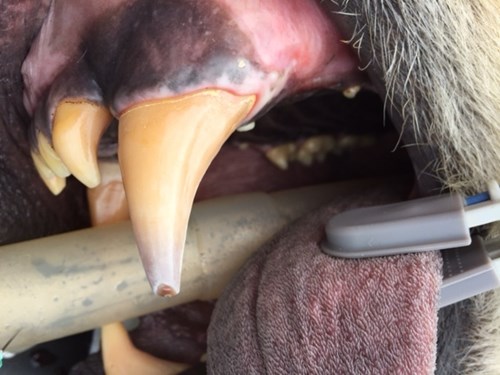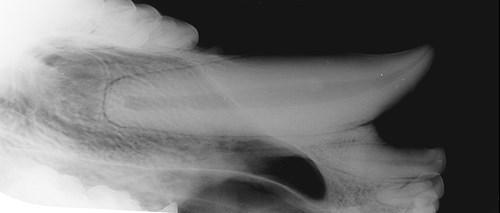RZSS Vet blog: the sharp end of animal dentistry
21/04/2016 in RZSS
Back in 2015, Walker – one of two male polar bears at RZSS Highland Wildlife Park – was noted to have chipped the tip off his upper left canine tooth. Whilst he wasn’t in any apparent discomfort, we performed a full examination under anaesthesia to make a better assessment. The good news was that no treatment was required at the time; however, we did suggest a repeat examination just to ensure the tooth wasn’t deteriorating. Arktos’ move across the Park to meet Victoria in early March presented the perfect opportunity. Whilst dental examinations and treatment are a routine part of the veterinary department’s work, it isn’t every day that we have to anaesthetise a 500 kg polar bear! Highland Wildlife Park vet Jane Harley, RZSS vet Adam Naylor, and RZSS vet nurse Donna Brown were therefore grateful for the assistance of veterinary anaesthesiologist Eddie Clutton and his team from the Royal (Dick) School of Veterinary Studies.

The day started early at the Park, with Walker first being darted with a combination of anaesthetic drugs. Once asleep, a tube was passed into his airway so that continued gas anaesthetic drugs could be administered. A team of more than ten staff were then needed to move Walker onto a specialised inflatable examination table designed for horses. Veterinary dental specialist Norman Johnston and his team could then get to work assessing the tooth.
Even though the broken fragment of tooth was relatively small, the team were concerned that it could allow infection into the tooth’s fragile growing core (the pulp cavity). If infected, extensive root canal treatment – including cleaning, removing and filling the tooth’s internal core – would be necessary. We rarely perform complete removal of canine teeth in large carnivores due to the difficulty in getting such large teeth out. For starters, the whole tooth may measure over 15cm in length!

In order to assess the health of the tooth, Norman took a series of x-ray images so that he could evaluate the quality of the tooth dentin (the hard body of the tooth), the periodontal ligament (the strong connections which hold the tooth into its socket), and the surrounding bone of the jaw. The good news was that he was pleased with his findings; other than some cosmetic discolouration, the tooth appeared to be healthy. Based on Norman’s assessment, the team decided not to treat further at this stage. After a general health check, including blood tests and a physical examination, Walker was brought round from the anaesthesia. He recovered well and the keepers were happy to report he was back to his usual self the next morning. The keepers and veterinary department will keep a close eye on the tooth and will be back to recheck it later in the year.
 Dr Adam Naylor
Dr Adam Naylor
Veterinary Surgeon Resident to the RZSS
Featured Articles

An update from the Budongo Forest
19/04/2024 in Conservation

Edinburgh Zoo named best zoo in Scotland
15/04/2024 in Edinburgh Zoo
Latest News
-
Blog

24/10/2023
Caring for penguins at Edinburgh Zoo and beyond
Through their expertise and research, our vet team provide the highest standard of care for our animals and make important contributions to understanding how we can better protect wildlife. Dr. Stephanie Mota shares more about their recent research on a fungal disease which affects penguins.
-
News

29/06/2022
UK’s first diabetic giant anteater fitted with monitor used for humans
Vets and keepers at the Royal Zoological Society of Scotland (RZSS) are managing the first reported case of diabetes in a giant anteater at Edinburgh Zoo with a blood glucose monitor usually used on humans.
-
News

03/05/2022
Sad news from Koala Territory
Sadly, we have to announce the loss of Goonaroo, one of our Queensland koalas at Edinburgh Zoo.
-
News

29/03/2022
Annual penguin catch up at Edinburgh Zoo
Over 100 penguins at the Royal Zoological Society of Scotland’s (RZSS) Edinburgh Zoo had their annual health check earlier this month.

























Follow EZ